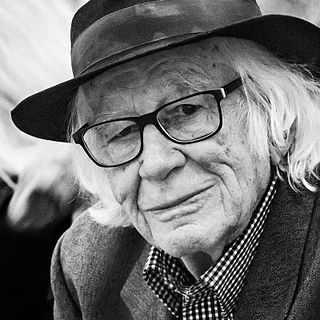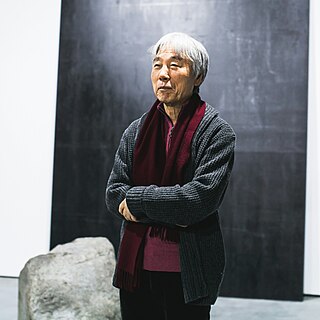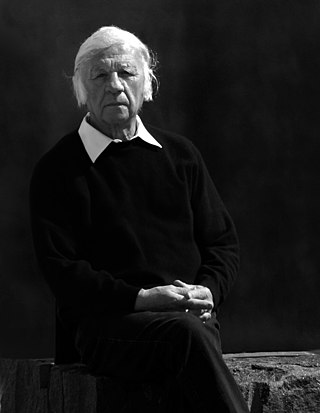
Sir Anthony Douglas Cragg is an Anglo-German sculptor, resident in Wuppertal, Germany since 1977.

Documenta is an exhibition of contemporary art which takes place every five years in Kassel, Germany.

David Hall was an English artist, whose pioneering work contributed much to establishing video as an art form.
James Lee Byars was an American conceptual artist and performance artist specializing in installations and sculptures, as well as a self-considered mystic. He was best known for his use of personal esoteric motifs, and his creative persona that has been described as 'half dandified trickster and half minimalist seer'.

Fritz Koenig was one of the most important international German sculptors of the 20th century.

Ralf Winkler, alias A. R. Penck, who also used the pseudonyms Mike Hammer, T. M., Mickey Spilane, Theodor Marx, "a. Y." or just "Y" was a German painter, printmaker, sculptor, and jazz drummer. A neo-expressionist, he became known for his visual style, reminiscent of the influence of primitive art.
Neil Jenney is an American painter and sculptor born on November 6, 1945 in Torrington, Connecticut, and working in New York City.

Lee Ufan is a Korean minimalist painter, sculptor, and academic, known for innovative bodies of work emphasizing process, materials, and the experiential engagement of viewer and site, and critiques of European phenomenology.
Social sculpture is a phrase used to describe an expanded concept of art that was invented by the artist and co-founder of the German Green Party, Joseph Beuys. Beuys created the term "social sculpture" to embody his understanding of art's potential to transform society. As a work of art, a social sculpture includes human activity that strives to structure and shape society or the environment. The central idea of a social sculptor is an artist who creates structures in society using language, thoughts, actions, and objects.

7000 Oaks – City Forestation Instead of City Administration is a work of land art by the German artist Joseph Beuys. It was first publicly presented in 1982 at documenta 7.
Charles Townsend Harrison, BA Hons (Cantab), MA (Cantab), PhD (London) was a UK art historian who taught Art History for many years and was Emeritus Professor of History and Theory of Art at the Open University. Although he denied being an artist himself, he was a full participant and catalyst in the Art and Language group.

Abraham David Christian is a German sculptor.

Heinz Mack is a German artist. Together with Otto Piene he founded the ZERO movement in 1957. He exhibited works at documenta in 1964 and 1977 and he represented Germany at the 1970 Venice Biennale. He is best known for his contributions to op art, light art and kinetic art.
Michael Sandle is a British sculptor and artist. His works include several public sculptures, many relating to themes of war, death, or destruction.
Mono-ha (もの派) is the name given to an art movement led by Japanese and Korean artists of 20th-century. The Mono-ha artists explored the encounter between natural and industrial materials, such as stone, steel plates, glass, light bulbs, cotton, sponge, paper, wood, wire, rope, leather, oil, and water, arranging them in mostly unaltered, ephemeral states. The works focus as much on the interdependency of these various elements and the surrounding space as on the materials themselves.

Kumi Sugai was a Japanese painter and printmaker. Driven by an interest in avant-garde painting, Sugai moved to Paris in 1952 where he quickly attracted critical attention, participating in numerous exhibitions in Paris and abroad. First working in a style resembling informalism or lyrical abstraction, he became affiliated with the Nouvelle École de Paris. During the early 1960s, his artworks radically transformed when he developed a hard-edge abstract style influenced by his interest in automobiles and contemporary urban living. While he did not officially associate himself with any single artistic movement or group, he collaborated on multiple projects with his poet friends, Jean-Clarence Lambert and Makota Ōoka.

Mária Bartuszová (1936–1996) was a Slovakian sculptor known for her abstract white plaster sculptures. Her work is included in the Centre Pompidou in Paris, the Slovak National Gallery in Bratislava and the Tate in London. Her artwork is part of curated selection of Venice Biennale titled "Milk of Dreams", Arsenale Area

David Bainbridge was a British sculptor, Conceptual Artist and member of the artist group Art & Language.
Robert Strawbridge Grosvenor is an American contemporary sculptor, installation artist, and draftsman. He is known for his monumental room installations, which border between sculpture and architecture. Grosvenor is associated with minimalism.

Heinz Trökes was a German painter, printmaker and art teacher.














